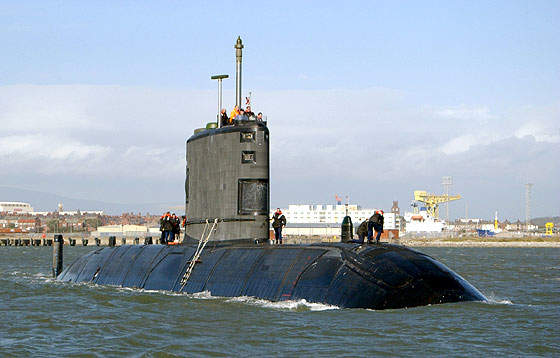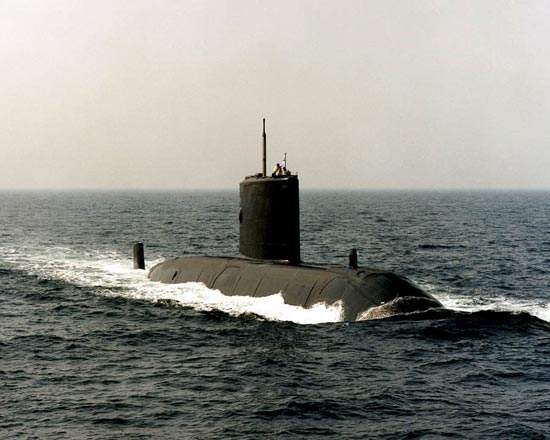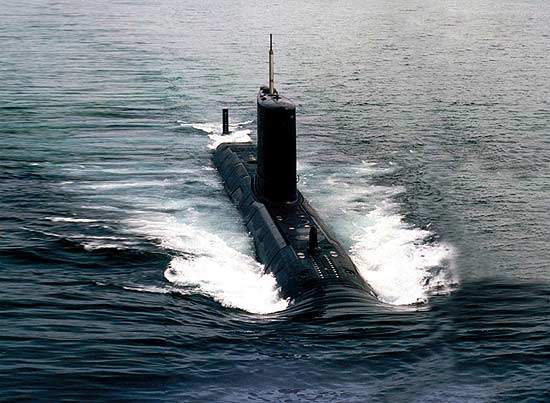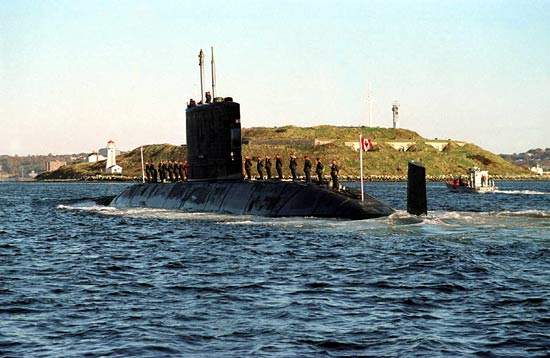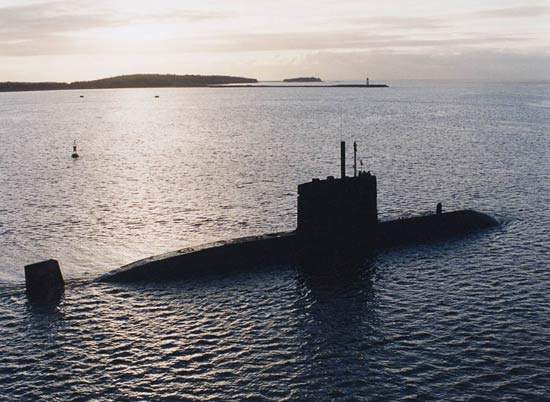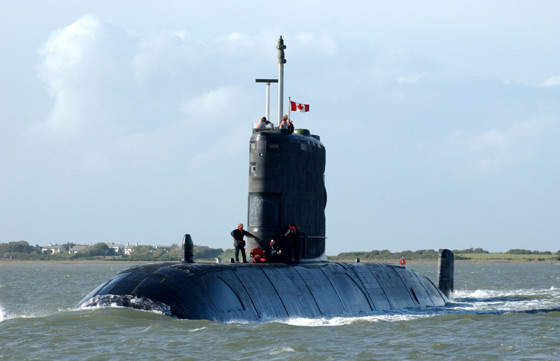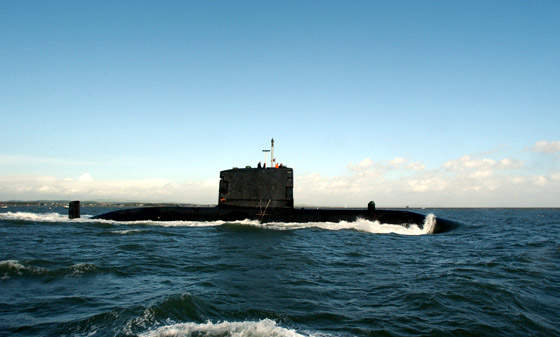The Canadian Maritime Force has purchased four Victoria (formerly Upholder) class diesel-electric submarines from the UK Royal Navy – HMCS Victoria (876), HMCS Windsor (877), HMCS Corner Brook (878) and HMCS Chicoutimi (879). The Victoria Class replace the decommissioned Oberon Class, the last of which was retired in July 2000. The first of class, HMCS Victoria, was commissioned in Halifax in December 2000 and the second, Windsor, in June 2003. Corner Brook was delivered in March 2003.
HMCS Chicoutimi
Work on the fourth vessel, HMCS Chicoutimi, was completed in September 2004. The vessel was handed over to the Canadian Navy at Faslane Naval Base in Scotland in October 2004.
While sailing from the UK to Halifax, Canada, a serious electrical fire broke out on the vessel. The submarine was rescued by UK Royal Navy Type 23 frigate, HMS Montrose, which towed the stricken vessel to Faslane. One crew member died in the accident.
Chicoutimi was loaded on a Norwegian sealift vessel in January 2005, to be returned to Halifax for repairs. The Canadian Navy decided to keep all the Victoria submarines ‘alongside’ until the causes of the accident were fully investigated. A first Board of Inquiry report was submitted in December 2004 and a supplementary report in March 2005. Safety improvements were carried out to the vessels and, in May 2005, they returned to sea. In April 2006, it was decided to defer repairs to HMCS Chicoutimi until 2010, when the vessel began a two-year refit.
Victoria / Upholder class submarines
The UK’s Upholder (Type 2400) class submarines were built by Vickers Shipbuilding and launched in the late 1980s and early 1990s. They were withdrawn from service in the British Royal Navy in 1994, following a defence review by the UK government. Canada purchased the submarines and a suite of trainers in 1998 and BAE Systems (formerly Vickers Shipbuilding) at Barrow in UK were contracted to refit the submarines. The submarines were then transferred to Halifax in Canada for commissioning.
One submarine, HMCS Victoria, operates in the Maritime Forces Pacific (MARPAC) fleet which has a base at Esquimalt near Victoria in British Columbia. Three submarines will operate within the Maritime Forces Atlantic (MARLANT) fleet based in Halifax base.
The submarines are a central component of each of the two high-readiness task groups, the Contingency Task Group which operates on 10 days’ readiness for deployment and the National Task Group which operates on 60 days’ readiness.
Victoria Class submarine design
The submarine has a single-skin hull constructed of NQ1 high-tensile steel. The skin of the submarine is fitted with about 22,000 elastomeric acoustic tiles to reduce the submarine’s acoustic signature.
The hull is a classical teardrop shape design, 70.3m in length by 7.6m in width and with a depth of hull of 5.5m. The fin or main sail houses a five-man lockout chamber.
The submarine’s escape and rescue system has been extensively upgraded with additional stowage space for escape stores and an underwater telephone to meet the Canadian Maritime Force requirements.
The hull displacement is 2,168t surfaced and 2,455t dived.
The submarine accommodates a crew of 48 including seven officers. There is room for an additional five mission crew, observers or training crew.
Weapon systems
Lockheed Martin Canada, Lockheed Martin Undersea Systems and Northstar Technical Inc (based in St John’s, Newfoundland) upgraded and installed the submarine’s Lockheed Martin Librascope Torpedo Fire Control System (TFCS) to meet the operational requirements of the Canadian Navy. Components from the fire control system of the Oberon submarines were removed and installed. A UHF DAMA satellite communications system has also been fitted.
The submarine has six 533mm (21in) bow torpedo tubes equipped with air pumped discharge systems. The Upholder Class sub-harpoon missile-firing and mine-laying capabilities have been removed. The torpedo room or weapons storage compartment houses racks for storing up to 18 Gould Mk 48 Mod 4 heavyweight torpedoes.
The torpedoes, operating at 40kt, are deployed against targets over a range of 50km. The torpedo range is 38km at speeds of up to 55kt. The torpedoes use active and passive homing to approach the designated target.
Countermeasures
The ship is fitted with two Submerged Signal Ejectors (SSE), small vertical discharge tubes which can launch either acoustic or bubble decoys.
The antenna of the passive Condor Systems Sea Search II Electronic Support Measures (ESM) unit is fitted to the CK35 mast. The Sperry Guardian Star intercept radar also provides ESM.
Sensors
The Victoria Class submarine is equipped with the CK 35 search periscope and the CH 85 attack optronic periscope supplied by Thales (formerly Pilkington) Optronics. The CK35 search periscope incorporates a binocular optical system with an optical target ranging system. The CH85 attack periscope incorporates a monocular optical system and an infrared system. It is primarily used for surveillance and attacks on surface targets.
The submarine’s long range sonars are the Thales Underwater Systems Type 2007 flank array sonar and the Thales Underwater Systems Type 2046 towed array sonar, both operating in passive mode and low frequency for long range detection and location. The Canadian Towed Array Sonar (CANTASS) has been integrated into the towed sonar suite.
The Thales Underwater Systems Type 2040 hull-mounted sonar installed in the bow is a passive search and intercept sonar operating at medium frequency for optimum medium-range performance.
Navigation
The navigation suite includes a global positioning system, and a Kelvin Hughes Type 1007 and a Foruno portable navigation radar both operating within the I-band frequency range.
Northrop Grumman Sperry Marine was awarded a contract in February 2005 to provide the Mk 49 inertial navigation system, based on ring laser gyro technology.
Propulsion
The submarine is fitted with a diesel electric propulsion system driving a single shaft, based on two Paxman Valenta 16SZ diesel engines each rated at 2.7MW sustained power with two 2.8MW Alsthom alternators and an Alsthom motor rated at 4MW. The propulsion and power systems are controlled from the machinery control room.
For operation under ice, the Victoria Class submarines could be fitted with an air-independent power system. The installation of an air-independent propulsion system might be considered in a future refit or upgrade program.
Performance
The surface speed is 12kt and the dived speed is 20kt. In snorting mode, travelling at low speed at periscope depth using an extendable air breathing system, the submarine can continue at up to 12kt. The range at an 8kt snorting speed is 8,000 miles. The submarine has a patrol endurance of 56 days.
The hull is rated to a diving depth over 200m.

